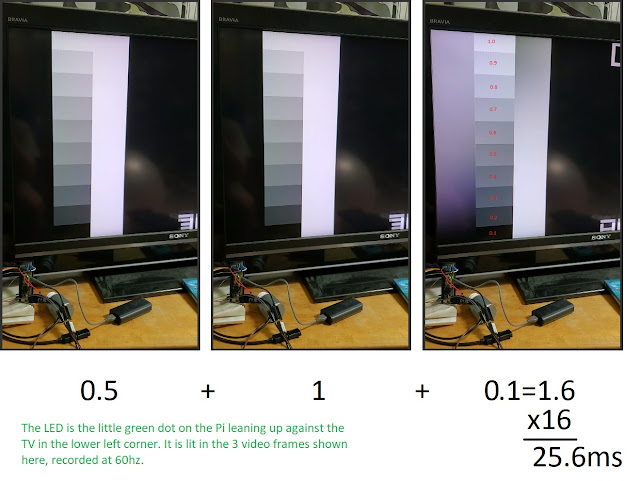Vizio VX20L HDTV review: input lag and upscaling tested using the piLagTesterPRO
This 720p TV from 2007 is rather mediocre, with variable input lag, aliasing, and in general very little to recommend it for gaming, retro or otherwise.
Image quality
Good upscaling is critical for retro gaming. Ideally, all pixels should appear equally sharp and bright (no aliasing), and angled lines should appear smooth, with no jagged, irregular steps. Also important is that the display shows most or all of the pixels it is sent. Often, this is not the case, with some number of pixels cropped from the bottom or top edges. Shockingly, these tests are relevant for modern gaming as well, because even at their native resolution many TVs have aliasing and cropping.
The set has no options to adjust cropping/scaling. At least not without the remote. 480i/p is displayed stretched to 16:9.
| resolution | aliasing | cropping (top, side) |
| 480p/i | mild | 20, 30 |
| 720p | bad | 30, 40 |
| 1080p | mild | 40, 60 |
Aliasing is quite bad at the tv's "native" resolution of 720p. 1080p actually looks better, though of course not all detail is resolvable. Supposedly the actual panel resolution is 1366x768.
The display has 2 HDMI, VGA, and 1 yPbPr input. I only tested HDMI.
Input Lag
I used a piLagTesterPRO to measure input lag. This device sends a frame of video over HDMI and measures how long it takes to display it. This display does not have a game mode; just a game 'color' preset that does not impact lag at all. I toggled all the display quality settings and did not see a consistent effect on lag, however the tests reported are with every "enhancement" set to off.
Complicating things significantly, this is yet another display that does not actually sync refresh to the input signal - instead it fills its own internal frame buffer from the video input and then draws that with an additional delay that is randomly determined each time you turn on the set or switch inputs, and slowly changes over time. Take one example, input lag for 720p can vary from 20.4ms to 35.5ms. What you get seems to be entirely up to chance. It can't even properly synchronize the display of this buffer with the refresh rate of the input: if the input is 60hz, then it rapidly drifts out of sync every 10 seconds or so and has to drop a frame. For 59.94 (aka NTSC) refresh rates, it does better, but still drifts out of sync slowly, taking several minutes before it has to drop a frame.
I've elected to report the average lag values here, since that seems fairest, but there's no right answer; for more discussion of this issue see the above link. It's worth noting however, that this kind of changing lag is the hardest for your brain/hands to adapt to. I'd much rather have an extra 16ms of fixed lag added to the display than one like this where sometimes the extra lag is 0, and sometimes it's 16ms.
Full Test Results
I report two kinds of values. 1st response measures how long it takes for the TV to start responding (I use a 5% change in display brightness). This overly optimistic value doesn't tell how long it takes to see anything useful, but matches what other reviewers call input lag. full response is a more realistic measure of lag, and requires the display to reach 80% of it's final brightness. This combines both input lag and response time, and is closer to what you would actually experience in a game.Results compared to other displays
This TV is part of the very large group with an average min lag of 28ms. Most of the sets with variable lag have this value as well, suggesting common components. It's response time is below average, however, so in the end it's in the bottom 3rd of my list.
Conclusion
Other models (to avoid)
I tested the VX20L HDTV, which is the 20" version. There appears to be two versions: Based similarities in their names, I suspect that the VX32L and VX37L would perform similarly, just with bigger pixels. However, I've made no efforts to check if their specs exactly match the VX20L so that's only a quick guess. Another model of almost the same age, the V022L, has been tested and performs exactly the same as this one.



Comments